The Argumentative Essay
AP Language & Composition Exam
What does the argumentative essay require of you?
- Basically, you must do three things:
- understand the nature of the position taken in the prompt;
- take a specific stand—argue, qualify, or disagree—with the assertion in the prompt; and
- clearly and logically support your claim.
Agree, Disagree, Qualify
- Do I think about this subject in the same way as the writer/speaker? (Agree)
- Do I think the writer/speaker is totally wrong? (Disagree)
- Do I think some of what is said is correct and some incorrect and do I feel lucky? (Qualify)
Plan before you write!
- Brainstorm a list of ideas, construct a chart, or create an outline…whatever it is, give yourself time to THINK about your position!
- The kinds of support you need:
- Facts/statistics - Details - Dialogue
- Quotations - Definitions - Anecdotes
- Contrast and comparison - Cause and Effect
- Appeal to authority - Examples
Does it matter what tone is taken in your argumentative essay?
- You can choose to be informal and personal, formal and objective, or even humorous and irreverent—just be certain your choice is appropriate for your purpose.
Will I be penalized for taking an unpopular, unexpected, irreverent, or bizarre position on the given issue?
- As long as you are addressing the PROMPT and appropriately supporting your position, there is no danger of losing points on your essay.
- Your essay is graded for process and mastery and manipulation of language, not for how close you come to the viewpoint of your reader.
Suggested time distribution for the argumentative essay:
- 1-3 minutes reading and working the PROMPT
- 3 minutes deciding on a position
- 10-12 minutes planning the support of your position
- 20 minutes writing the essay
- 3 minutes proofreading!
The argumentative essay prompt
In his famous “Vast Wasteland” address to the National Association of Broadcaster in May of 1961, Newton Minow, the Chairman of the Federal Communications Commission, spoke about the power of television to influence the taste, knowledge, and opinions of its viewers around the world. Carefully read the following, paying close attention to how timely it is today, especially in light of the worldwide Internet.
Minow ended his speech warning that “The power of instantaneous sight and sound is without precedent in mankind’s history. This is an awesome power. It has limitless capabilities for good—and for evil. And it carries with it awesome responsibilities—responsibilities which you and [the government] cannot escape…”
Using your own knowledge and your own experiences or reading, write a carefully constructed essay that defends, challenges, or qualifies Minow’s ideas.
Mark your copy of the prompt…take about 3 minutes.
In his famous “Vast Wasteland” address to the National Association of Broadcasters in May of 1961 , Newton Minow , the Chairman of the Federal Communications Commission , spoke about the power of television to influence the taste, knowledge, and opinions of its viewers around the world . Carefully read the following, paying close attention to how timely it is today, especially in light of the worldwide Internet.
Minow ended his speech warning that “The power of instantaneous sight and sound is without precedent in mankind’s history . This is an awesome power . It has limitless capabilities for good—and for evil . And it carries with it awesome responsibilities —responsibilities which you and [the government] cannot escape …”
Using your own knowledge and your own experiences or reading , write a carefully constructed essay that defends, challenges, or qualifies Minow’s ideas.
Developing the opening paragraph
- Refer specifically to the prompt
- Clearly state your position on the given issue
Newton Minow’s assertion to the national Association of Broadcasters that “The power of instantaneous sight and sound is . . . An awesome power . . . With capabilities for good—and for evil” is valid and true. However, placing the responsibility for this power squarely in the hands of the broadcasters and the government is in error.
Qualifies the assertion
The writer agrees with the potential of the power, but disagrees about who should take responsibility.
Imagine being gifted the limitless capability for good and evil—the ability to control the world with one’s super powers. And, what are these powers? X-ray vision? Morphability? Immortality? NO, it is the most awesome power ever devised—the instantaneous influence over the taste, knowledge and opinions of mankind around the world. Even Superman would get a headache from this kind of power! This is not a great gift, it is an “awesome responsibility” according to the Newton Minow’s 1961 warning to the National Association of Broadcasters.
Agrees with the assertion
The writer agrees with Minow’s position but treats the assertion in a lighthearted fashion. The reader can expect a humorous and possibly irreverent tone in the essay.
Nowhere is the awesome power for good and evil of modern technology more clearly seen than in the Internet’s pervasiveness and influence. Newton Minow was right on target in 1961 when he warned the National Association of Broadcasters that the power of TV has “limitless capabilities for good—and for evil.”
The writer agrees with Minow’s position, BUT has LIMITED the area of the argument to that of the Internet.
Developing the body of the essay
- After carefully reading and deconstructing the prompt, choose a way to organize your argument
- One way (for this prompt) would be to use Minow’s own three-part warning and brainstorm ideas based on those categories
Planning the essay (focus on Internet)
- Warning of dangers
- Recognition of heroes
- Involvement in humankind’s achievements
- Instant communications with family & friends
- Medical care
- Links to the world
- Entertainment
- Promote hate
- Distort reality
- Help terrorists
- Invasion of privacy
- Threats to nat’l security
- Create mass hysteria
- Exploit children
- Subvert elections
- Brainwashing
- Responsibility
- Self-censorship
- Prior restraint
- 1 st Amendment
- Financial gain
- Parental control
- Personal checks and balances
Choose those specific items you will best be able to support and develop
A sample body paragraph based on the first list:
One of the most rewarding applications of the Internet is its ability to provide instant communication between friends and family. A grandmother-to-be in New York is able to share in the moment by moment experience of her daughter’s pregnancy and her granddaughter’s birth in California through e-mail, scanned photos and quick videos . Likewise, the ability to instantly communicate with others may have saved the life of a doctor stranded at the South Pole. Her contact with medical resources and experts via the Internet enabled her to undergo surgery and treatment for breast cancer. Research and innovations in medical treatment are now available to those around the world via the “net.” Similarly, the ability for instance communication enables millions to enjoy concerts, sports events, theatrical presentations and other cultural activities without every having to leave home. These wonderful benefits are all because of the fabulous and awesome technological creation—the Internet.
Remember IDEAL ?
Analysis (explain)
One of the most rewarding applications of the Internet is its ability to provide instant communication between friends and family. A grandmother-to-be in New York is able to share in the moment by moment experience of her daughter’s pregnancy and her granddaughter’s birth in California through e-mail, scanned photos and quick videos. Likewise, the ability to instantly communicate with others may have saved the life of a doctor stranded at the South Pole. Her contact with medical resources and experts via the Internet enabled her to undergo surgery and treatment for breast cancer . Research and innovations in medical treatment are now available to those around the world via the “net.” Similarly, the ability for instance communication enables millions to enjoy concerts, sports events, theatrical presentations and other cultural activities without every having to leave home. These wonderful benefits are all because of the fabulous and awesome technological creation—the Internet.
A sample body paragraph based on the second list:
The other side of the mass communication coin has the face of evil on it. The Internet offers hate mongers unlimited access to anyone with a connection to the World Wide Web. Groups like the Neo-Nazis can spread their hate messages to susceptible minds via bright, entertaining and engaging websites. What looks like a simple, fun game can easily reinforce the group’s hate-filled philosophy to unsuspecting browsers. With the potential for millions of “hits” each week, it does not take a rocket scientist to perceive the danger here. This danger is also present with the minds and bodies of curious and vulnerable
young people. Because of its easy access and easy production, “kiddie porn” is both possible and available via the Internet and the films any number of porn sites offer for downloading with the mere click of a keyboard key. Through contacts made through e-mail and/or chat rooms on the Net, children can be easily fooled and led to contact those who would abuse their bodies and minds for a quick profit or cheap thrill. With instantaneous messaging, whether real or imagined, positive or negative, a single person or group can set into motion mass hysteria just by warning of an impending disaster, such as a flood, fire, bomb, poison, and son on. There are obviously many more possibilities floating out there in the ethernet. These are just three of the evil ones.
A sample body paragraph based on the THIRD list:
Just as there is the potential for both good and evil with regard to mass communication, so too is there the potential for both beneficial and destructive strategies related to reponsibilities. The most powerful regulator of our responsibility as individuals is our finger and its power to press a button or double click on a key and to “just say no.” With this slight pressure, we are able to exert monumental pressure on those who produce programs, websites, photos, documents, etc., which we find unacceptable. Who better to tell us what to watch, what to do, and what to think? All too
Often many people prefer to abdicate their personal responsibility and give that power to either the government or the communication industry. We must never forget that dictators target the control and censorship of mass media as the first step in the total control of the minds and hearts of the populace. The laws, which we as citizens of a democracy look to, must never impinge upon our First and Fourth Amendment rights. Each of us has the right of free speech, and each of us has the right to privacy. None of us has the right to harm others or to limit the rights of others; why, then, would we give that right to the communication industry or to the government?
The concluding paragraph
- Spend your time in planning and writing the body of your essay
- In a brief essay, you can be certain your reader can remember what you’ve already said, so there is no need to summarize your major points or to repeat the prompt.
- If you feel you MUST have a concluding statement/remark, make certain it is a FINAL remark that is of interest and is appropriate to your purpose
- You may use the last sentence of your last body paragraph as your concluding comment.
Yes, this concluding sentence IS a little on the giddy side…
Argumentative Practice Essay
- Refer to your notes
- Don’t take shortcuts
- I’ll put times up on the board
- You’ll get the whole 40 minutes to go through the entire process

- My presentations

Auth with social network:
Download presentation
We think you have liked this presentation. If you wish to download it, please recommend it to your friends in any social system. Share buttons are a little bit lower. Thank you!
Presentation is loading. Please wait.
Writing an Argumentative Essay
Published by Cordelia Ellis Modified over 9 years ago
Similar presentations
Presentation on theme: "Writing an Argumentative Essay"— Presentation transcript:
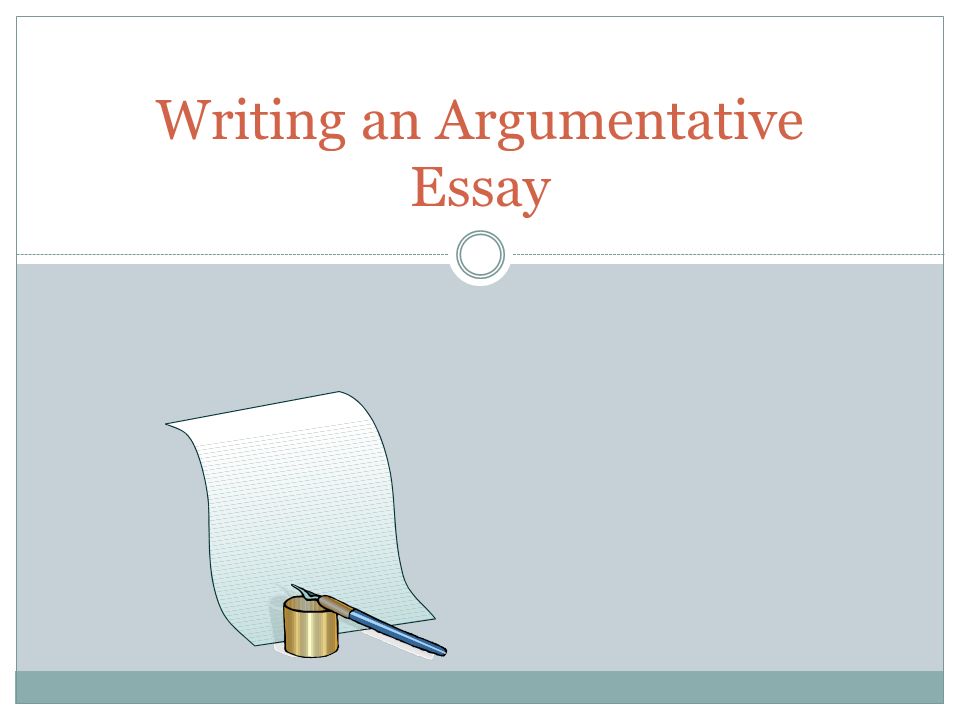
Argumentative Writing

Persuasive Essay Writing The art of persuading someone to think like you!

Writing an Argumentative Paragraph

How to write a THESIS STATEMENT A thesis statement answers the question asked of you. (Is Ms. Harper amazing?) A thesis statement is a claim (has to have.

Argumentative Essay.

Expository Writing.

Paragraphs A good paragraph has the following key elements: A main idea expressed in a topic sentence (your reasons) Details supporting the main idea (your.

Essay Outline Poetry Unit.

The Three Parts of an Essay

The “How and Why” of Writing

Let’s Review Some Things, Class Days ‘til KPREP: 19.

Writing the 5 Paragraph Essay. Introduction Three Parts Attention Grabber Claim/Argument 3 Reasons your argument is true.

A how-to guide. Introduction: Start with an attention getter. For literary analysis, this should be some background information related to the piece of.

Body Paragraphs Writing body paragraphs is always a T.R.E.A.T. T= Transition R= Reason/point from thesis/claim E= Evidence (quote from the text) A= Answer.

The Argumentative Essay. This just won’t cut it...

Argumentative Essay Standard: ELAGSE6W1

Invention and Arrangement

TODAY WE ARE GOING TO LEARN... HOW TO WRITE AN EXPOSITORY ESSAY !!!!!!

Take out a piece of paper and take notes…

Argumentative Essay Standard: ELACC6W1. What is it? An essay that is used to state and support claims written with clear reasons and relevant evidence.
About project
© 2024 SlidePlayer.com Inc. All rights reserved.
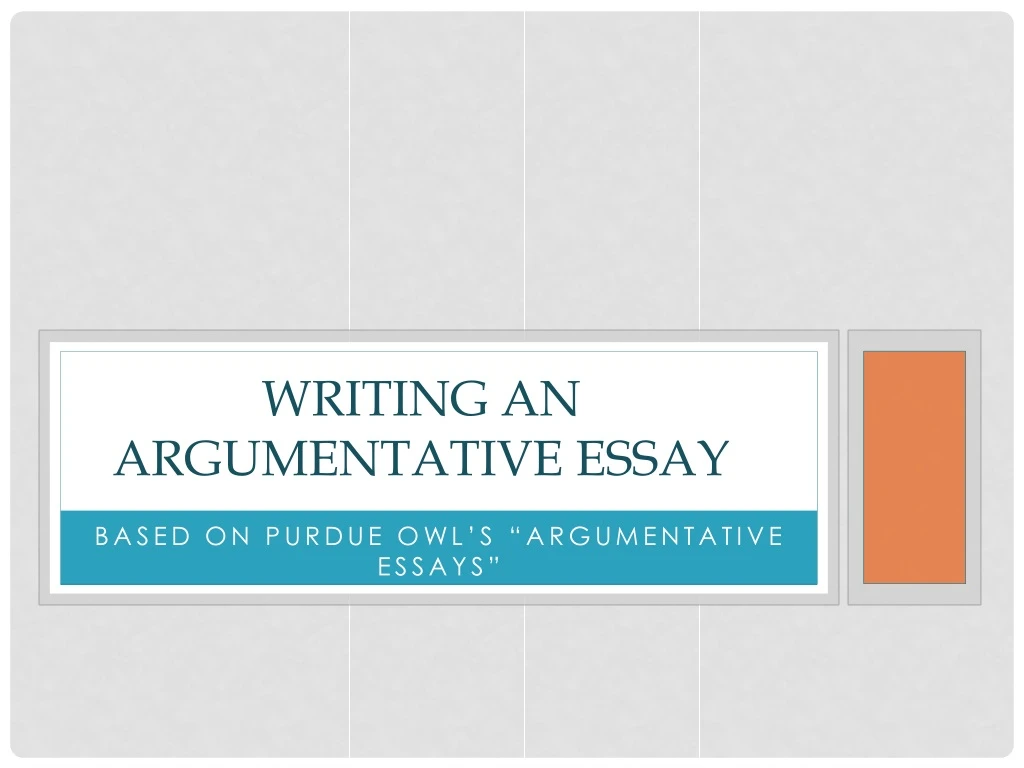
Writing an Argumentative Essay
Oct 31, 2019
280 likes | 603 Views
Writing an Argumentative Essay. Based on Purdue Owl’s “Argumentative Essays”. What is an Argumentative Essay?. The argumentative essay is a genre of writing that requires the writer to: Develop a topic via researching credible sources
Share Presentation
- thesis statement
- thesis argument
- argumentative essays
- thesis argument topic
- ve taught sunday school

Presentation Transcript
Writing an Argumentative Essay Based on Purdue Owl’s “Argumentative Essays”
What is an Argumentative Essay? The argumentative essay is a genre of writing that requires the writer to: • Develop a topic via researching credible sources • Create a clear, concise, and defined thesis statementthat occurs in the first paragraph of the essay • Construct body paragraphs that include evidential support (whether factual, logical, statistical, or anecdotal) • Write in proper argumentative style; i.e. logical transitionsand a firm and concise tone • Develop a conclusion that does not simply restate the thesis, but readdresses it in light of the evidence provided
Have you chosen your topic yet? • If not, use this presentation as a means to brainstorm. • If so, pay close attention to how this presentation applies to your topic!
Credible Sourcing • Published books *available at our duPont-Ball Library • Peer-reviewed, academic journals *available through our duPont-Ball Library website • An argumentative essay may warrant reference to newspaper articles or other less reputable sources. When in doubt, ask your professor whether your source is a credible one.
Flow chart on researching here, Preliminary tips • Good academic writing is considered “direct.” • Deal immediately with the topic at hand without unnecessary information/examples • Use clear and precise language even to describe taboo topics or abstract ideas • Consider using a flow chartto connect premises/claims to evidence/sources to conclusions/applications • Bubble mapscan help keep you focused on a main idea by linking sections or arguments back to the central argument
Chart Examples
What is a Good Argument? Consider an argument that: • Can be support with factual evidence • Is specificenough to hold a focus • Has multiple perspectives and stances • You are passionate about
Elements of a Convincing Argument • Authoritative voice, “Ethos” • What makes you a qualified writer on the topic? • Draw from expertise of other credible theorists, or may draw from personal experience • Appeal to reason, “Logos” • Where logical statements come into play • The reader is lead to agree with you because conclusions/implications follow reasonably from premises • Appeal to audience, “Pathos” • Often misunderstood as a purely emotional appeal, but is really a method of finding common ground with the reader • Ex: the writer can appeal to ethical, humanist ideals, assuming the audience is a generally ethical crowd
Examples Ethos “You know me - I've taught Sunday School at your church for years, babysat your children, and served as a playground director for many summers - so you know I can run your preschool.” Pathos “After years of this type of disrespect from your boss, countless hours wasted, birthdays missed… it's time that you took a stand.” Logos “More than one hundred peer-reviewed studies have been conducted over the past decade, and none of them suggests that this is an effective treatment for hair loss.”
Writing a Thesis Statement A thesis is not: • A title • An announcement of the subject • A statement or absolute fact The MLA Handbook or Writer of Research Papers, 7th ed. defines a thesis statement as “a single sentence that formulates both your topic and your point of view.”
Writing a Thesis Statement A good thesis statement is unified:
Writing a Thesis Statement Try to be as specific as possible without providing too much detail:
The Tolumin Method Claim: Your thesis/argument topic Data: Evidence and research that you will use to support your thesis Warrant/Bridge:Explanation of the data and how it supports your thesis; The underlying assumption that connects your data to your claim Backing/Foundation:Additional information that is necessary to support your warrant/bridge Counterargument: An argument that disagrees with your thesis/argument Rebuttal:Explanation and evidence that disagrees with the counterargument
Incorporating Sources Through the Tolumin Method Claim: Hybrid cars are an effective strategy to fight pollution. Data 1:Driving a private car is a typical citizen’s most air polluting activity. Warrant 1:Because cars are the largest source of private, as opposed to industry produced, air pollution, switching to hybrid cars should have an impact on fighting pollution. Data 2: Each vehicle produced is going to stay n the road for roughly 12 to 15 years. Warrant 2:Cars generally have a long lifespan, meaning that a decision to switch to a hybrid car will make a long-term impact on pollution levels.
Incorporating Sources Through the Tolumin Method Data 3: Hybrid cars combine a gasoline engine with a battery-powered electric motor. Warrant 3: This combination of technologies means that less pollution is produced. According to ineedtoknow.org “the hybrid engine of the Prius, made by Toyota, produces 90 percent fewer harmful emissions than a comparable gasoline engine.”
Cite Your Sources • When you use words or ideas from any source (whether it is a book, a website, a video, a television show, or a person you interviewed) • When you use or reprint images, charts, graphs, or other data from any source • When in doubt, cite (or ask your instructor)
Plagiarism Common issues include: • Neglecting to cite information that is not common knowledge • Neglecting to use quotation marks around borrowed words. • Neglecting to cite information or ideas that were summarized or paraphrased • Incorrectly paraphrasing (for example, changing only a word or two) Stetson’s Honor Pledge does not distinguish between intentional plagiarism and improper use of sources. Therefore, students must use care when working with sources and know when and how to give credit to sources.
The Counterargument • The counterargument addresses the claims that oppose your audience. • It may be located before or after your main claim. • It demonstrates your credibility. • It respectfully recognizes concerns that your audience might have. • For this reason, you must be both tactful and firm when presenting a counterargument.
Revisiting the Tolumin Method Counterargument: Instead of focusing on cars, which still encourages a culture of driving even if it cuts down on pollution, the nation should focus on building and encouraging use of mass transit systems. Rebuttal:While mass transit is an environmentally sound idea that should be encouraged, it is not feasible in many rural and suburban areas, or for people who must commute to work; thus hybrid cars are a better solution for much of the nation’s population.
Argumentative Style • Academic writers in argumentative essays generally keep a tone of high certainty, meaning their assertions are not too weak. • Writers should avoid hedgingin argumentative essays, as this vague language lowers the validity of an argument. • Hedge Words: • Probably, will, should, might, maybe • Perhaps, usually, likely
Pronoun Use • “I” • The first person perspective is not forbidden in formal essays, but some professors and genres of writing discourage it • It places importance on the writer and his/her experiences/opinions rather than on the subject material • “We” • Is rarely used because it refers to a specific group of individuals that often remains ill-defined • May run into the problem of misrepresentation • “You” • Is most discouraged because of misrepresentation—the writer cannot know for sure who the reader is and so should not make assumptions • For hypotheticals, use “one” • “They” • Issue with gendered pronouns in English: “his or her” excludes gender ambiguous people and “they” refers to plural third person, not singular. • When in doubt, use “one”
What makes an essay flow? • Using transition statements in between topic paragraphs • Linking sentences and ideas together with conjunctions • Having a clear and concise organization where supporting ideas refer back to the argument of paper
Transitioning in an Argumentative Essay “It is a good idea to continue one paragraph where another leaves off. Picking up key phrases from the previous paragraph and highlighting them in the next can create an obvious progression for readers.” • Given/New sentence formation: • The first part of the sentence refers to the fact established previously in the essay (given), while the last part springboards off the given facts to provide more information/argumentation/analysis (new)
Example I “Overall, Management Systems International has logged increased sales in every sector, leading to a significant rise in third-quarter profits” Example II “Fearing for the loss of Danish lands, Christian IV signed the Treaty of Lubeck, effectively ending the Danish phase of the 30 Years War”
Concluding • The conclusion of an argumentative essay should rearticulate your thesis and explain the importance of your claim. • Some conclusions consider solutions to the argument at hand. • Some conclusions make predictions on the future of the argument.
The Tolumin Method: Argumentative Essay Example Claim: Your thesis/argument topic Data: Evidence and research that you will use to support your thesis Warrant/Bridge:Explanation of the data and how it supports your thesis; The underlying assumption that connects your data to your claim Backing/Foundation:Additional information that is necessary to support your warrant/bridge Counterargument: An argument that disagrees with your thesis/argument Rebuttal:Explanation and evidence that disagrees with the counterargument https://www.mesacc.edu/~paoih30491/ArgumentEssay2.pdf
References • http://academicguides.waldenu.edu/writingcenter/scholarlyvoice/avoidingbias • https://owl.english.purdue.edu/owl/resource/683/01/ • https://owl.purdue.edu/owl/general_writing/academic_writing/essay_writing/argumentative_essays.html • https://owl.purdue.edu/owl/general_writing/common_writing_assignments/argument_papers/index.html • https://www.mesacc.edu/~paoih30491/ArgumentSampleEssays.html#MarkAgainst
- More by User
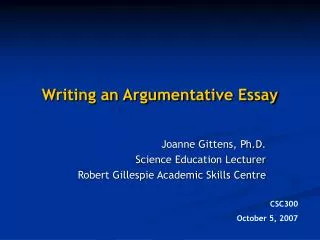
Writing an Argumentative Essay. Joanne Gittens, Ph.D. Science Education Lecturer Robert Gillespie Academic Skills Centre. CSC300 October 5, 2007. Writing Goals for an Argumentative Essay. Grab your readers attention State a clear thesis Identify your reasons for asserting your thesis
1.05k views • 14 slides
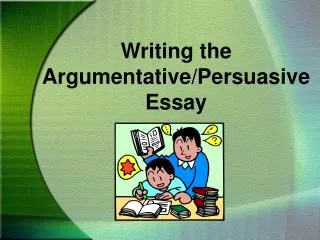
Writing the Argumentative/Persuasive Essay
Writing the Argumentative/Persuasive Essay. CHOOSING A TOPIC. To begin an argumentative/persuasive essay, you must first have an opinion you want others to share. . Possible Topic Ideas. Should legal immigration be stopped? Should dying people be kept on life support?
545 views • 22 slides


WRITING AN ARGUMENTATIVE ESSAY
WRITING AN ARGUMENTATIVE ESSAY. Essay 1. PERSUASION/ARGUMENT. PERSUASION - REFERS TO THE VARIOUS WAYS THAT AUTHORS ENCOURAGE READERS TO ACCEPT THEIR POSITION ARGUMENT -REFERS TO THE USE OF LOGIC AND EVIDENCE TO CONVINCE READERS. CHOOSING A DEBATABLE TOPIC.
307 views • 11 slides

Writing an Argumentative Essay. Introduction. Attention Grabber (question, statistic, onomatopoeia, anecdote) Ex. What do you think of when you think of sports? I think of a rigorous competition between two opposing sides. Thesis sentence (opinion + 3 reasons)
293 views • 7 slides
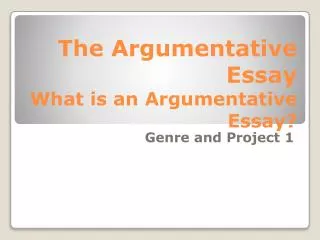
The Argumentative Essay What is an Argumentative Essay?
The Argumentative Essay What is an Argumentative Essay?. Genre and Project 1. Dictionary Definition. What are other genres of writing?. What is genre in writing?.
305 views • 11 slides
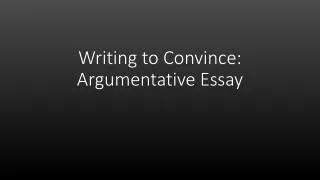
Writing to Convince: Argumentative Essay
Writing to Convince: Argumentative Essay. Position statement reminders. Is the thesis of your paper Should specifically state what you are trying to convince your audience to believe and/or do Should express your opinion (not a fact) about the issue under discussion
345 views • 15 slides
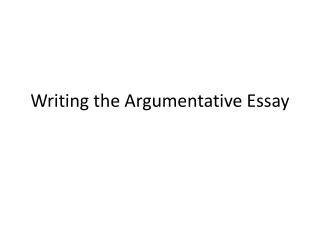
Writing the Argumentative Essay
Writing the Argumentative Essay . Introductory Paragraph . 1 st. Red: Hook- Pose a question , use facts or statistics, make a surprising statement, give a short anecdote. Green : Thesis statement- (Main Point & list of supports) UNDERLINE THE SUPPORTING IDEAS!.
948 views • 7 slides

Writing an Argumentative Essay. The Power of Persuasion. Before you begin to write an argumentative essay, you must first take a position. What is a position in an argumentative essay?.
290 views • 7 slides
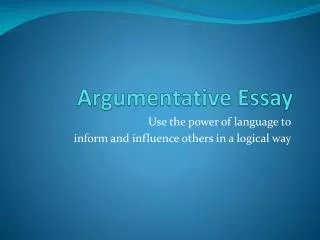
Argumentative Essay
Argumentative Essay. Use the power of language to inform and influence others in a logical way. Common Core standards. Write arguments to support claims in an analysis of substantive topics and text, using valid reasoning and relevant and sufficient evidence.
462 views • 9 slides

Argumentative Essay. Semester 1 Final Exam: Writing Component
226 views • 4 slides

Argumentative Essay. Feedback on First Draft. Key Areas for Improvement. Use the apostrophe correctly. Link each paragraph of your body section. Refute any arguments you introduce that oppose your stance. Ensure that your essay is between 750 and 1300 words and include a word count .
305 views • 9 slides

Writing the Argumentative Essay. By Caryl Bishop. Argumentation. “. . . the art of influencing others, through the medium of reasoned discourse , to believe or act as we wish them to believe or act.”. Structure of Argument . Claim Proposition Support Evidence Motivational Appeals
632 views • 23 slides
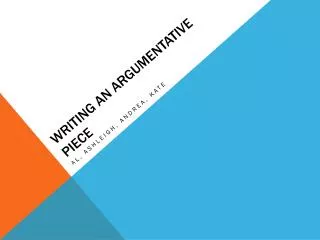
Writing an argumentative piece
Writing an argumentative piece. Al, ashleigh , andrea , kate. Writing an argumentative piece. Argumentative pieces are similar to writing a persuasive essay in which you want to try and persuade your audience. However, there are many aspects that make it different as well.
248 views • 10 slides
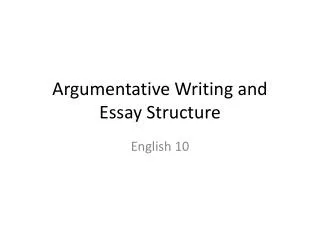
Argumentative Writing and Essay Structure
Argumentative Writing and Essay Structure. English 10. Define that please. ar·gu·men·ta·tive Adjective 1. given to expressing divergent or opposite views. 2. using or characterized by systematic reasoning. Components an introduction. 1. 2. 3. Attention getter or the Hook.
556 views • 12 slides
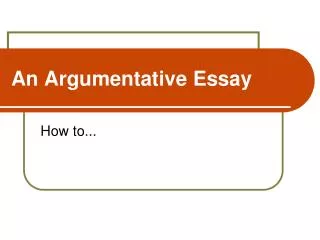
An Argumentative Essay
An Argumentative Essay. How to. Before Writing. Brainstorm ideas on the subject . Identify the main topics. Use these topics as headings for organising your notes.
286 views • 12 slides

An Argumentative Essay. How to. Before Writing. Brainstorm ideas on the subject . Identify the main topics. Use these topics as headings for organizing your notes.
207 views • 12 slides

Argumentative Essay. Opening Paragraph. The first sentence has the lead Second and maybe third sentences explain the book The last sentence contains your opinion statement. Opening Paragraph: Outline. Argumentative Essay Outline:
980 views • 20 slides

Writing the Argumentative/Persuasive Essay. CHOOSING A TOPIC. To begin an argumentative/persuasive essay, you must first have an opinion you want others to share. Possible Topic Ideas. Should legal immigration be stopped? Should dying people be kept on life support?
438 views • 22 slides

Writing the Argumentative Essay. CHOOSING A TOPIC. To begin an argumentative essay, you must first have an opinion you want others to share. Possible Topic Ideas. Should legal immigration be stopped? Should dying people be kept on life support? Should tobacco products be banned?
437 views • 22 slides
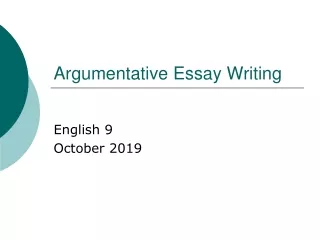
Argumentative Essay Writing
Argumentative Essay Writing. English 9 October 2019. The Purpose of Argumentative Writing. To persuade the reader or audience to see things from your point of view To get someone to do something To change someone’s mind. Steps in the Writing Process. Prewriting Planning/Outlining
297 views • 24 slides

Argumentative Essay. Writing in which the writer makes a claim about a topic and then supports it with logic and evidence. Paragraph # 1. Introductory paragraph “Hook” the reader State your claim The claim is the thesis statement. THESIS STATEMENT.
359 views • 9 slides

253 views • 22 slides

COMMENTS
This document provides information and guidance on writing argumentative essays. It defines key terms like argue, argumentative, and argument. It explains that an argumentative essay tries to logically persuade the reader to agree with the writer's point of view.
It defines key terms used in argumentation such as proponent, opponent, and counterargument. It explains that the goals of an argumentative essay are to present an opinion on a controversial topic, explain and support the opinion with evidence, and address counterarguments.
This document provides guidance on writing an effective argumentative essay in 3 paragraphs or less. It begins by explaining the purpose is to convince the reader of a particular point of view using facts and examples. Next, it covers the key components of an introduction, body and conclusion.
ARGUMENTATIVE WRITING STUDENT TASK GUIDE
2 WHAT ARE THE GOALS OF THE ARGUMENTATIVE ESSAY? present an opinion on a controversial topic to the reader; explain, clarify, and illustrate that opinion; persuade the reader that the opinion...
An argument is a series of statements with coherent reasoning supported by reliable, credible, sufficient evidence typically used to persuade someone of something or to present reasons for accepting a conclusion.
What does the argumentative essay require of you? Basically, you must do three things: understand the nature of the position taken in the prompt; take a specific stand—argue, qualify, or...
What is an Argumentative Essay? Goal Your Argumentative Essay will: The goal of an argumentative essay is to change the reader’s point of view, to bring about some action on the reader’s part, or to ask the reader to accept the writer’s explanation of an issue.
This powerpoint presentation provides: a definition for argumentative writing; examples of everyday arguments; elements of argumentative writing; ideas about how to organise an argumentative essay; practice prompts and much more!
The argumentative essay is a genre of writing that requires the writer to: • Develop a topic via researching credible sources • Create a clear, concise, and defined thesis statementthat occurs in the first paragraph of the essay • Construct body paragraphs that include evidential support (whether factual, logical, statistical, or ...